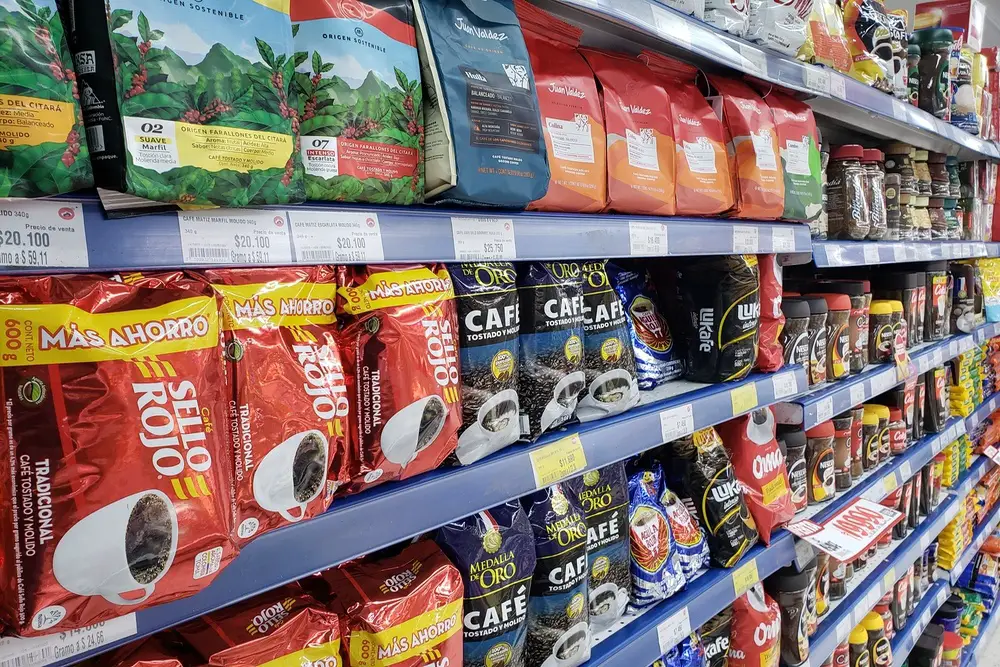Ever wondered why quality coffee is only grown in a few places?
It turns out that there is one geographic area in the world that offers ideal conditions for growing coffee.
Table of Contents
What and where is the coffee belt?
The coffee belt is a latitude between the tropics of Cancer and Capricorn.
The name refers to the equatorial regions of the world where coffee grows best. That is, between 25 degrees north and 30 degrees south of the equator.
All of these regions offer an optimal environment with their tropical climate, lush vegetation and ideal soil for the growth of coffee plants.
The coffee belt mainly spans 3 continents namely America, Africa and Asia. This horizontal band is approximately 3200 miles (5100 km) long from north to south.
About 40 of the 70 countries that make up the coffee belt produce large amounts of coffee. In fact, countries in this area can produce up to 20 billion pounds of coffee per year.
However, many of the countries that make up the coffee belt are also part of the Pacific Ring of Fire, which through its volcanic activity helps coffee plants to grow strong, healthy and tasty.
The Pacific Ring of Fire, also known as the Pacific Ring of Fire, is a region around the Pacific Ocean that contains about 75% of the world’s volcanoes.
Why is the coffee belt so important?
The coffee belt is of great importance for the coffee industry because, due to its privileged geographical location, it offers a number of conditions necessary for the coffee plant to grow and thrive.
Therefore, one should be aware that growing large amounts of coffee outside of the coffee belt does not make sense, since the conditions are not the best and it is very difficult for coffee to grow optimally there.
Humidity
It is interesting to know that coffee plants need a tropical climate with dry and wet seasons.
In this sense, the rainy season provides large amounts of water for the coffee plants. This helps many coffee farmers who rely on rain as it is their only source of water.
On the other hand, dry seasons provide an opportunity to harvest the coffee cherries in which the coffee beans are embedded. This harvest season lasts about 2 to 3 months during which the cherries are picked while they are ripe.
In general, most countries have only a single harvest season, although some countries like Colombia have a second, slightly shorter harvest season.
In summary, coffee cultivation requires a constant relative humidity between 50 and 70%.
Temperature
Coffee plants need stable temperatures as they respond to both extreme cold and heat. Many plants cannot tolerate sudden changes in temperature and therefore need temperatures between 15°C and 30°C.
Altitude
Most of the coffee grown worldwide is grown at an altitude of 1000 to 2000 meters above sea level, in an area where there are not large temperature fluctuations.
Because of this, the coffee that is grown at altitude is given a desirable acidity, similar to that of wine.
It is also worth knowing that altitude is very important for low caffeine plants as they are less susceptible to pest infestation.
Likewise, the higher the coffee is grown, the more expensive it is, since there is little land in these areas, cultivation is difficult and there is less suitable labor available.
Floor
The soil provides the necessary nutrients that are not found in water and air.
In order for the coffee to thrive, the soil must be well drained, so loamy or sandy soils are unsuitable. The condition of the soil is also important so that it can withstand the dry periods.
Soil pH is also an important factor in plant growth, as many tropical regions have slightly acidic soils, which is very favorable for coffee growing.
Countries that make up the coffee belt
The following are the main regions of the coffee belt with their respective countries:
Asia
Coffee beans from this region are generally heavier-bodied and can exhibit earthy notes and spicy aromas. Additionally, the climate and high altitude of the Asia-Pacific region favor the growth of Robusta cultivars over Arabic.
Asian countries in coffee belt
- Thailand
- India
- Vietnam
- Myanmar (ex. Burma or Burma)
- Indonesia
- Papua New Guinea
- China
- Nepal
- Philippines
America
The coffees from this region are known for their balanced taste, their caramel sweetness and their mild acidity. Due to the large number of farms and the overall volume of production, there is a wide variety of flavors in this region.
American e countries in the coffee belt
- Mexico
- Cuba
- Guatemala
- Haiti
- El Salvador
- United States
- Panama
- Nicaragua
- Jamaica
- Dominican Republic
- Costa Rica
- Brazil
- Colombia
- Ecuador
- Peru
- Bolivia
- Paraguay
- Venezuela
Africa
In this region, the coffee cherries have a longer ripening process, resulting in beans with a higher intensity. Therefore, African beans require higher temperatures for the heat to reach the center of the green beans. The coffees from this region are characterized by notes of citrus fruits, chocolate and floral aromas.
African countries in coffee belt
- Ethiopia
- Kenya
- Malawi
- Zambia
- Rwanda
- Zimbabwe
- Burundi
- Congo
- Ivory Coast
- Uganda
- Yemen
- Gabon
- Ghana
- Guinea
- Liberia
- Madagascar
- Sierra Leone
- Trinidad and Tobago
- Timor Leste
Which are the most important coffee-growing countries in the world?
There are two types of coffee, Arabica and Robusta. In fact, 70% of the world’s coffee supply is made up of Arabica beans and the remaining 30% is made up of Robusta beans.
The main difference lies in the soil on which the coffee tree stands and in size: Robusta coffee beans are larger than Arabica coffee beans.
Arabica coffee comes from regions that are more than 900 meters above sea level and where the temperature is usually around 20°C. That is why it is mainly grown in countries such as Brazil, Kenya, Ethiopia, Colombia, Asia, especially India and Central America.
This coffee retains its characteristics, is more aromatic, fragrant and its notes are easier to distinguish.
The Robusta coffee, on the other hand, can be grown at lower altitudes and is more tolerant of climatic changes. It is therefore more resistant to pest infestation. Robusta coffee is grown in African countries, Indonesia and Brazil.
It has a higher caffeine and sugar content than arabica, which affects its bitterness and makes it a little lighter.
Brazil
Type of coffee produced: Arabica and Robusta.
Coffee growing areas: Paraná, Minas Gerais, Mato Grosso do Sul, São Paulo, Bahia, Cerrado do Bahia, Chapada Diamantina, Chapada de Minas, Matas de Minas, Espírito Santo, Mato Grosso, Sul de Minas and Planalto de Bahia.
Vietnam
Type of coffee produced: Robusta and Arabica.
Coffee growing regions: North Vietnam, South Vietnam and Central Highlands.
Colombia
Type of coffee produced: Arabica.
Coffee growing areas: Huila, Caldas, Antioquia, Valle del Cauca, Cauca, Nariño, Cundinamarca, Tolima, Santander, Norte de Santander, Quindío and Risaralda.
Indonesia
Type of coffee produced: Arabica and Robusta.
Coffee growing regions: Sulawesi, New Guinea, Bali, Flores, Sumatra and Java.
Ethiopia
Type of coffee produced: Arabica.
Coffee growing regions: Sidama, Limu, Gimbi, Harrar, Yirgacheffe and Jima.
Honduras
Type of coffee produced: Arabica.
Coffee growing areas: Copán, Agalta, El Paraíso, Comayagua, Opalaca and Montecillos.
India
Type of coffee produced: Arabica and Robusta.
Coffee growing regions: Chikmagalur, Coorg, Andhra Pradesh, Karnataka, Bababudangiri, Kerala, Nilgiri, Manjarabad, Travancore, Wayanad, Pulney, Tamil Nadu and Sheravoy.
Mexico
Type of coffee produced: Arabica and Robusta.
Coffee growing regions: Veracruz, Chiapas and Oaxaca.
Peru
Type of coffee produced: Arabica.
Coffee growing areas: Cusco, Junín, San Martín and Cajamarca.
Uganda
Type of coffee produced: Robusta and Arabica.
Coffee growing regions: Western Uganda, West Nike, Centram Lowlands and Bugisu.
Guatemala
Type of coffee produced: Arabica and Robusta.
Coffee growing areas: Fraijanes, Cobán, San Marcos, Nuevo Oriente, Huehuetenango, Antigua, Acatenango and Atitlán.
Nicaragua
Type of coffee produced: Arabica and Robusta.
Coffee growing areas: Matagalpa, Nueva Segovia and Jinotega.
China
Type of coffee produced: Arabica and Robusta.
Coffee growing regions: Hainan, Yunnan and Fujian.
Malaysia
Type of coffee produced: Robusta.
Coffee growing regions: Sebah, Sellangore, Malacca, Kelantan, Terengganu and Kedah.
Cote d’Ivoire (Ivory Coast)
Type of coffee produced: Robusta.
Coffee growing areas: Western Highlands, Abboiso Divo and Abengourou,
Cote d’Ivoire
Type of coffee produced: Arabica.
Coffee growing regions: Tres Ríos, Turrialba, Orosi, West Valley, Brunca, Central Valley, Tarrazú and Guanacaste.
Tanzania
Type of coffee produced: Arabica and Robusta.
Coffee growing regions: Mbeya, Ruvuma, Kilimanjaro, Tarime, Arusha and Kigoma.
Papua New Guinea
Type of coffee produced: Arabica and Robusta.
Coffee growing regions: Eastern Highlands, Western Highlands and Chimbu.
Thailand
Type of coffee produced: Robusta.
Coffee shops: Lampang, Chumphon, Chiang Mai, Krabi, Chiang Rai, Mae Hong Son, Ranong, Phang Nga und Si Thammarat
The Savior
Specified: Arabica
Coffee trees: Apaneca-Ilamatepec Mountains, Alotepeque-Metapan Mountains, Chinchontepec Volcano, Cacahuatique Mountains, Tepeaca-Chinameca Mountains and El Balsamo Mountains of Quezaltepec.
Kenya
Specified: Arabica
Coffee shops: Meru, Nakuru, Embu, Kiambu, Kirinyaga, Machakos, Kisii, Murang’a, and Nyeri.
Venezuela
Specified: Arabica
Coffee drinks: Bolivar, Carabobo, Zulia, Anzoategui Aragua, Falcon, Cojedes, Lara, Merida, Guarico, Miranda, Portuguese, Monagas, Táchira, Yaracuy and Sucre.
Philippines
Specified: Robusta and Arabica
Coffee growing regions: Cordillera Administrative Region, Calabarzon, Mindanao, Mimaropa and Visayas.
Which countries are characterized by the specific taste of their coffee?
Below is a list of some countries that stand out for the taste of their coffee:
Colombia
Colombian coffee is characterized by its balance and light body. It has chocolate, nutty, fruity and floral aromas.
Guatemala
Coffee produced in Guatemala has a wide range of flavors, ranging from strong, chocolaty coffees to sweeter, fruitier cups.
Sumatra
Sumatran coffee has a dense body and its aroma has earthy and spicy notes.
Costa Rica
Costa Rican coffee is very pure with a wide range of fruit flavors and a sugary sweetness.
Ethiopia
Ethiopian coffee has a fruity taste and excellent aroma with notes of bergamot, lavender and jasmine.
Kenya
Kenyan coffee is complex, medium-bodied and has strong acidity, as well as fruity and floral notes.
Coffee Belt oddities
- The coffee belt has nitrogen-rich soils and a high nutrient density, allowing coffee to thrive.
- The moderate temperature fluctuations between day and night favor rapid ripening of the coffee fruit.
- Abundant rainfall in the mountainous regions of the coffee belt favors the growth of coffee plants.
- Coffee cultivation in the coffee belt began around 1600 in Ethiopia, the “cradle of coffee”, later also in other countries such as Yemen and some Middle Eastern countries.
- Coffee grown at higher elevations tends to be of higher quality and therefore more sought after by Deep L lovers.
- Coffee from higher elevations is fruitier and fresher than coffee from lower elevations.
- High-elevation coffee is more labor-intensive, as there is little arable land available at higher elevations.
- But many other things also grow in the coffee belt, most notably avocados, bananas, pineapples and cocoa.
- Quality coffees, also known as high mountain coffees, are grown at altitudes of 1500 meters and more.
- Arabica and Robusta coffee varieties do not tolerate freezing temperatures, so it is not possible to cultivate coffee when planting at temperatures below 12 °C.
- In Ethiopia, the cradle of coffee, there are more than 1000 types of coffee.
How is climate change affecting the coffee belt?
According to experts, acreage is shrinking due to deforestation, fungus, drought and disease, which could affect coffee supplies.
In addition, the equatorial regions have experienced higher temperatures and less precipitation in recent decades. These factors can lead to a variety of threats to coffee plants, such as B. Coffee grate and coffee berry borer.
There is no doubt that climate change poses a very serious threat to coffee growing. Climate researchers and environmentalists even warn that the usable area under coffee cultivation in the coffee belt could be halved by 2050.



